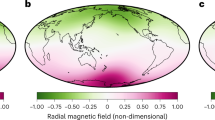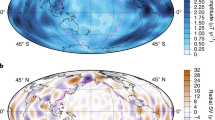Abstract
We investigate the temporal behaviour of the axial component of the electromagnetic core-mantle coupling torque that is associated with the poloidal part of the geomagnetic field observable at the Earth surface. For its computation, we use different models of the geomagnetic field, expanded into spherical harmonics (Wardinski and Holme, 2006; Sabaka et al., 2004), and the mantle conductivity. The geomagnetic field, which we have to know at the core-mantle boundary for the associated computations, will be inferred from the field at the Earth surface by the non-harmonic field continuation through a conducting mantle shell. The aims of this investigation are (i) to check how sensitive is the computation of the torque with respect to the different geomagnetic field models, (ii) to check its dependence on the spherical harmonic degree n, and (iii) to determine the difference between the mechanical torque derived from the observed length-of-day variations (atmospheric influence subtracted) and the poloidal electromagnetic torque in dependence on the assumed conductivity. To use the non-harmonic field continuation for the torque calculation and to obtain an insight into the influence of the different geomagnetic field models on the EM torques are the major aspects of this paper.
Similar content being viewed by others
References
Ballani L., Greiner-Mai H. and Stromeyer D., 2002. Determining the magnetic field in the core-mantle-boundary zone by non-harmonic downward continuation. Geophys. J. Int., 149, 374–389.
Benton E.R. and Whaler K.A., 1983. Rapid diffusion of the poloidal geomagnetic field through the weakly conducting mantle, a perturbation solution. Geophys. J. R. astr. Soc., 75, 77–100.
Buffett B.A., 1992. Constraints on magnetic energy and mantle conductivity from the forced nutations of the Earth. J. Geophys. Res., 97, 19,581–19,587.
Buffett B.A., Jeanloz R. and Garnero E., 2000. Sediments at the top of Earth’s core. Science, 290, 5495–5497.
Dubrovinsky L., Dubrovinskaia N., Langenhorst F., Dobson D., Rubie D., Gessmann C., Abrikosov I.A., Johansson B., Baykov V.I., Vitos L., Le Bihan T., Crichton W.A., Dmitriev V. and Weber H.P., 2003. Iron-silica interaction at extreme conditions and the electrically conducting layer at the base of the Earth’s mantle. Nature, 422, 58–61.
Greiner-Mai H., 1987. The influence of the electromagnetic core-mantle coupling torques on Earth’s rotation. Astron. Nachr., 308, 217–226.
Greiner-Mai H., 1993. Decade variations of the Earth’s rotation and geomagnetic core-mantle coupling. J. Geomagn. Geoelectr., 45, 1333–1345.
Greiner-Mai H. and Jochmann H., 1998. Correction to ‘Climate variations and the Earth’s rotation’. J. Geodyn., 25, 1–4.
Greiner-Mai H., Ballani L. and Stromeyer D., 2004. The poloidal geomagnetic field in a differentially rotating upper core layer. Geophys. J. Int., 158, 864–873.
Gubbins D. and Roberts P.H., 1987. Magnetohydrodynamics of the Earth’s Core. In: J.A. Jacobs (Ed.), Geomagnetism, Volume 2. Academic Press, London.
Holme R., 1998a. Electromagnetic core-mantle coupling-I. Explaining decadal changes in the length of day. Geophys. J. Int., 132, 167–180.
Holme R., 1998b. Electromagnetic core-mantle coupling-II. Probing deep mantle conductance. In: M. Gurnis, M.E. Wysession, E. Knittle and B.A. Buffett (Eds.), The Core-Mantle Boundary Region., AGU Geodynamic Series, 28, AGU, Washington D.C., 139–151.
Holme R., 2000. Electromagnetic core mantle coupling III. Laterally varying mantle conductance. Phys. Earth Planet. Inter., 117, 329–344.
Krause F. and Rädler K.-H., 1980. Mean-Field Magnetohydrodynamics and Dynamo Theory. Akademie-Verlag, Berlin.
Olsen N., Lühr H., Sabaka T.J., Mandea M., Rother M., Tøffner-Clausen L. and Choi S., 2006. CHAOS-a model of the Earth’s magnetic field derived from CHAMP, Ørsted, and SAC-C magnetic data. Geophys. J. Int., 166, 67–75.
Ono S., Oganov A.R., Koyama T. and Shimizu H., 2006. Stability and compressibility of the high-pressure phases of Al2O3 up to 200 GPa: Implications for the electrical conductivity of the base of the lower mantle. Earth Planet. Sci. Lett., 246, 326–335.
Paulus M. and Stix M., 1989. Electromagnetic core-mantel coupling: The Fourier method for the solution of the induction equation. Geophys. Astrophys. Fluid Dynam., 47, 237–249.
Ponsar S., Dehant V., Holme R., Jault D., Pais A. and Van Hoolst T., 2003. The core and fluctuations in the Earth’s rotation. In: V. Dehant, K.C. Creager, S. Karato and S. Zatman (Eds.), Earth’s Core: Dynamics, Structure, Rotation. AGU Geodynamic Series, 31, AGU, Washington D.C., 251–261.
Roberts P.H., 1972. Electromagnetic core-mantle coupling. J. Geomagn. Geoelectr., 24, 231–259.
Rochester M.G., 1960. Geomagnetic westward drift and irregularities in the Earth’s rotation. Phil. Trans. R. Soc. London, A252, 531–555.
Rochester M.G., 1962. Geomagnetic core-mantle coupling. J. Geophys. Res., 67, 4833–4836.
Sabaka T.J., Olsen N., Langel R.A., 2002. A comprehensive model of the quiet-time, near-Earth magnetic field: phase 3. Geophys. J. Int., 151, 32–68.
Sabaka T.J., Olsen N. and Langel R.A., 2004. Extending comprehensive models of the Earth’s magnetic field with Ørsted and CHAMP data. Geophys. J. Int., 159, 521–547.
Shankland T.J., Peyronneau J. and Poirier J.P., 1993. Electrical conductivity of the Earth’s lower mantle. Nature, 366, 453–455.
Stix M., 1982. On electromagnetic core-mantle coupling. Geophys. Astrophys. Fluid Dynam., 21, 303–313.
Stix M. and Roberts P.H., 1984. Time-dependent electromagnetic core-mantle coupling. Phys. Earth Planet. Inter., 36, 49–60.
Voorhies C.V., 1991. Coupling an inviscid core to an electrically insulating mantle. J. Geomagn. Geoelectr., 43, 131–156.
Wardinski I. and Holme R., 2006. A time-dependent model of the earth’s magnetic field and its secular variation for the period 1980 to 2000. J. Geophys. Res., 111, doi:10.1029/2006JB004401.
Wessel P. and Smith W.H.F., 1991. Free software helps map and display data. Eos Trans. AGU, 72, 445–446.
Author information
Authors and Affiliations
Additional information
grm@gfz-potsdam.de
Rights and permissions
About this article
Cite this article
Greiner-Mai, H., Hagedoorn, J., Ballani, L. et al. Axial poloidal electromagnetic core-mantle coupling torque: A re-examination for different conductivity and satellite supported geomagnetic field models. Stud Geophys Geod 51, 491–513 (2007). https://doi.org/10.1007/s11200-007-0029-0
Received:
Revised:
Accepted:
Issue Date:
DOI: https://doi.org/10.1007/s11200-007-0029-0




